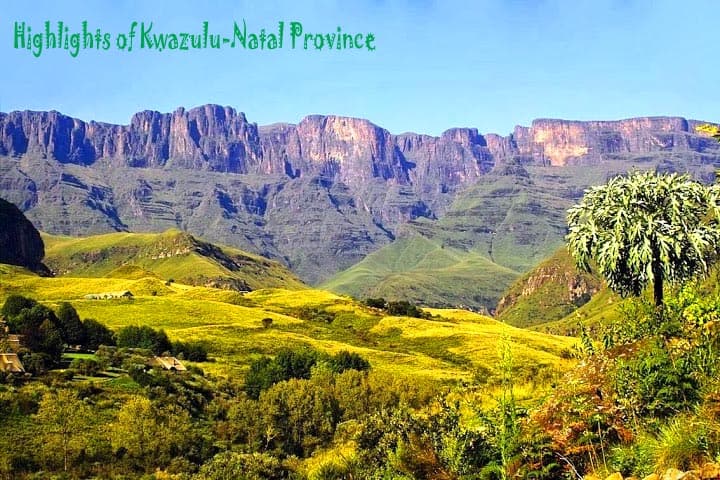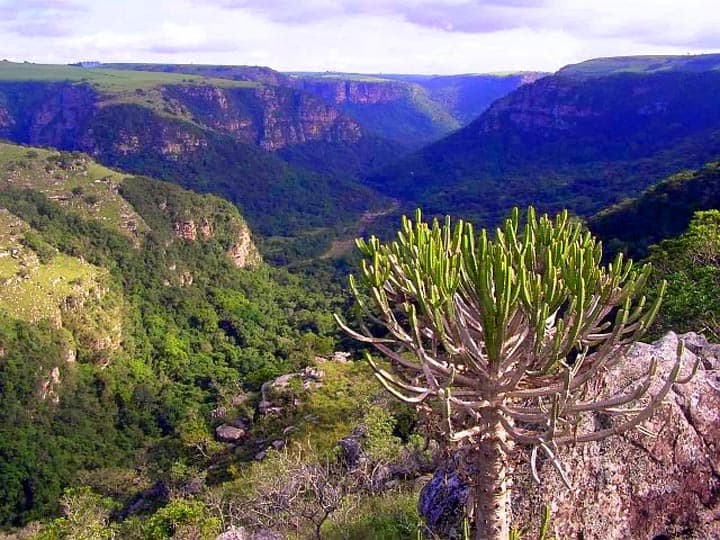
Above: Drakensberg Mountains
Coming north from the Eastern Cape Province (covered in the last post) brings you to Kwazulu-Natal Province (KZN). Most foreign visitors will be surprised to hear that this is the most visited province in the country, renowned for its beautiful beaches, tropical climate, and year-round sunshine – as well as its varied and beautiful landscapes. In KZN you can spend a day on the beach, swim with sharks, hike mountains (the beautiful Drakensberg) and gorges (the Oribi Gorge), visit the most densely inhabited habitat for hippos and crocodiles in the world (in the Greater Lake St-Lucia Wetland Park) and see white and black rhinos (in the Hluhluwe-Umfolozi National Parks). For cultural experiences, discover the country’s 3rd largest city (Durban) or immerse yourself in Zulu culture. There’s tons to see and do in Kwazulu-Natal.
I’ll cover KZN from South to North, continuing from the Wild Coast/Transkei where we last left off.
Above: image credit to away.com
The South Coast (The Hibiscus Coast)
The South Coast, covering 150 km from the Eastern Cape Province border up to Durban, has one absolute ‘must see’ highlight: the Oribi Gorge Nature Reserve. Arrange to spend at least one day here (the park has various accommodation options) and hike the beautiful and incredibly dramatic gorge.
The rest of the South Coast is made up of a string of beach resort communities and can be compared to the Costa del Sol or Miami Beach – a long stretch of beaches where you can swim and surf and enjoy the nightlife. With Durban being an easy train trip away, many travelers choose to stay in the cheaper accommodation options that line this coast; Amazimtoti and Kingsburgh are especially recommended for their wonderful beaches and easy accessibility to Durban.

Above: Oribi Gorge
Durban
Durban, the country’s 3rd largest city with 4 million people, is home to most of the nation’s Indian community. It’s also a major holiday destination, especially among South Africans from nearby Johannesburg and Pretoria. Besides the beaches, the city has several highlights: City Centre with its classic English colonial architecture; City Hall, Farewell Square, Playhouse Theatre, Old Railway station (now Tourist Info Central), Indian (Victoria) Market the largest Indian market in the world outside of India, the Ushaka Marine and Seaworld with the largest, best aquarium in the Southern Hemisphere (and 4th largest in the world) with South Africa’s marine life from both coasts. Ocean walks along the sea bottom, diving with the sharks – this is probably Durban’s top attraction and a definite ‘must-see’. Walk along Marine Park/Golden Mile, the 6 kms long Durban beachfront promenade. It’s worth seeing the Minipark and the Fitzsimons Snake park, also make sure to take a walk out onto one of the several jetties off the beach to get terrific views of the city.
Around the city: the Botanical Gardens are the oldest on the continent and one of the finest tropical gardens in the southern Hemisphere. The Umgeni Bird Park, 8 km from the city center, has over 800 birds, many being rare species. The KwaZulu-Natal Shark Board at Umhlanga Rocks is 15 km north of Durban and is another highlight in this area (Full coverage of that below).

Above: Durban
The North Coast (The Dolphin Coast )
Starting at Umhlanga Rocks and stretching 80 kms north from Durban to the Tugela River Mouth, the north coast is known as the Dolphin Coast, due to frequent sightings of bottlenose dolphins who ride the waves of the Indian Ocean in large frolicking schools. A beautiful stretch of coastline, it is far less developed than the south coast. Inland are fields of sugarcane, interspersed by attractive coastal towns buried in tropical vegetation and flowers.
Umhlanga Rocks is a lovely and lively town with beach walkways, nature trails and tropical park-like surroundings, making it a great base from which to visit Durban. It is also the site of The KwaZulu-Natal Shark Board – Umhlanga Rocks. The KZN Sharks Board maintains shark protection at 38 localities (through the use of nets) and is the only institute of its kind in the world, offering safe bathing to tourists while also conducting research into shark life. A boat trip out to the nets is an experience you will not experience anywhere else in the world!
Some of the pretty towns along the coast are worth a visit if driving through this area; Ballito, Shakas’ Rock, Salt Rock, Sheffield Beach. All are quiet, upscale, pretty towns with lovely beaches and a very laidback, relaxed lifestyle. A little further, Tugela Mouth marks the northern boundary of the North Coast – this spot has been the sight of many battles over the years and you’ll see the ruins of Fort Pearson (dating back to the Anglo-Zulu War) on the south bank of the river.
Shakaland, a traditional Zulu village built for the historical film Shaka Zulu (itself a ‘must-see’ for anyone visiting South Africa) is run as a cultural centre/hotel and has unique accommodation and traditional meals. For those interested in cultural experiences, it is a great spot to learn more about the Zulu culture, traditions, medicines, tools and arms (assegaai, spears) making.

Above: Shakaland
Far North of Kwazulu- Natal
North of the Tugela Mouth you are in historical traditional Zulu territory. Farming slowly changes from sugarcane to more pastoral (cattle) and maize growing. Zulu villages are generally spread widely over the countryside, being more a collection of various family compounds than villages as such – although many of the towns are of great historical significance to the Zulu nation they offer little to the average tourist. However, there are two “must-see” attractions are located in northern KZN, both very close to each other;
The Greater Lake St-Lucia Wetland Park- the largest natural freshwater lake, wetland area and marine park in the country is also a World Heritage Site. The village of St-Lucia is situated at the entrance to the National Park and has restaurants, hotels, and nightlife. But the environment is wild – It is common to see hippos wandering down the village streets at night, or to see them walking down the beach at the mouth of the lake after sunset. The lake itself, over 60 kms long, is the most densely inhabited locale for crocodile and hippos in the world. The entire area abounds with bird life – including the rare Fishing Eagle. This unique, wild natural attraction offers a wealth of ‘natural’ sports including horse riding along pristine white beaches and through the reserve.
The Hluhluwe-Umfolozi National Parks are renowned for their populations of Black and White Rhinos (both of which are rapidly disappearing worldwide). The parks have a huge variety of other wildlife including lions, leopards, elephant, and large herds of various antelope and buck. They lie in the middle of beautiful countryside, dominated by high rolling hills, low acacia forest and fever trees. As with all National Parks in South Africa, accommodations range from simple camp sites to chalets.

Above: Greater Lake St-Lucia Wetland Park (photo credit africansky.com)

Above: Rhinos at Hluhluwe-Umfolozi National Parks (photo credit: gomag.co.za)
Drakensberg Mountains
These iconic mountains form the border of Kwazulu-Natal and Lesotho. The highest, most impressive and spectacular ramparts of the Drakensberg are to be found at the Amphitheatre, and Mont-aux-Sources in the KZN Royal National Park, at Cathedral Peak , Champagne Castle and Cathkin Peak, situated further south in the central reaches of the mountain range, and at Giants’ Castle, in the KZN Drakensberg Park, in the southern section of the range. The highest peaks top the 3.400 meter level – the highest in Africa (with one exception – Kilamanjaro!). All the resorts, whether in the National Parks or otherwise, offer a full range of hiking, horseback riding, paragliding – even helicopter tours. Some of the most stunning, beautiful and intoxicating hikes, walks and climbs are here in the Drakensberg.

Above: Cathedral Peak, Drakensberg
If you have the time, before leaving the Zulu motherland, take a trip across the Valley of a Thousand Hills. It is an oddly unique landscape with deep ravines, thick forests, sugarcane fields and hundreds upon hundreds of Zulu villages and houses spread over the hillsides. The route from MooiRivier (on the Durban-Johannesburg motorway) through Greytown to Stanger cuts through the middle of the Thousand Hills and provides an excellent overview of the area.
Below: Zulu beehive huts

KwaZulu-Natal provides the visitor with just about everything they could ever wish for. This province is essential to any trip to South Africa.
——————————————————————————————————————————————————————————————-
The above is the 4th in a series of posts on South Africa contributed by my good friend (and proud South African) Tony Plowman.
For much more on this area, including off the Beaten path sites and activities, as well as many links and videos, click HERE.
A lot more material on South Africa can be found HERE.
If you’ve been to the KwaZulu-Natal I’d love to hear about your experiences. As always, appreciate any feedback!
Thank you for reading.
The post Highlights of Kwazulu-Natal Province, South Africa appeared first on The Travels of BBQboy and Spanky.
